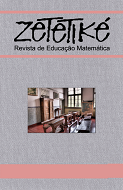Abstract
In view of the various global issues, research results report that creativity is of fundamental importance in personal and interpersonal relationships with objects of study during knowledge construction processes to obtain possible answers. To contribute to this scenario, the objective of this work refers to the construction of a Didactic Model for the Development of Creative Thinking in Mathematics (DM-CTM), based on investigations regarding creativity and its dimension in teaching and learning processes in mathematics. These investigations have enabled analysis and interconnections with fundamental elements of didactics, with the Anthropological Theory of Didactics and, more specifically, with the path of study and research. The DM- CTM is a theoretical construct that opens a range of possibilities for research on didactic phenomena having creativity as its aspect.
References
Aldon, G. (2011). Interactions didactiques dans la classe de mathématiques en environnement numérique: construction et mise à l’épreuve d’un cadre d’analyse exploitant la notion d’incident. (Thèse en Education: Didactique des mathématiques). Université Claude Bernard Lyon 1, 694 p. Disponível em : https://theses.hal.science/tel-00679121v2/document.
Aljarrah, A., & Babb, A.P.P. (2022). Shifting metaphors as a trigger for creativity: a review of students’ mathematical creative acts. In S. A. Chamberlin (Ed.), Proceedings of the 12th International Conference on Mathematical Creativity and Giftedness (MCG 12) (pp.59-65). Disponível em: https://d-nb.info/1268386723/34.
Bicer, Ali, Bicer, Ay., & Chamberlin, S. A. (2022). Young students’ mathematical creative thinking processes. In S. A. Chamberlin (Ed.), Proceedings of the 12th International Conference on Mathematical Creativity and Giftedness (MCG 12) (pp.93-96). Disponível em: https://d-nb.info/1268386723/34
Boaler, J. (2016). Mathematical Mindsets: unleashing Students’ Potential Through Creative Math, Inspiring Messages and Innovative Teaching. Jossey-Bass (A. Wiley Brand).
Brousseau, G. (2011). La théorie des situations didactiques en mathématiques. Éducation & Didactique, 5(1), (pp.101-104). https://doi.org/10.4000/educationdidactique.1005
Brousseau, G. (1978). L’observation des activités didactiques. Revue Français de Pedagogie, 45, (pp.130-139).
Bruhn, S. (2022). Supporting first graders in showing their individual mathematical creativity through (meta-) cognitive prompts. In S. A. Chamberlin (Ed.), Proceedings of the 12th International Conference on Mathematical Creativity and Giftedness (MCG 12) (pp. 97-103). Disponível em: https://d-nb.info/1268386723/34
Chamberlin, S.A., Payne, A., & Kozlowski, J. (2022). The five legs of creativity. In S. A. Chamberlin (Ed.), Proceedings of the 12th International Conference on Mathematical Creativity and Giftedness (MCG 12) (pp.116-121). Disponível em: https://d-nb.info/1268386723/34
Chevallard, Y. (1999). L’analyse des pratiques enseignantes en théorie anthropologique du didactique. Recherches en didactique des mathématiques, 19(2), 221–266.
Chevallard, Y. (2001). Les TPE comme problème didactique. Communication au Séminaire national de didactique des mathématiques (pp.1-9). Disponível em: http://yves.chevallard.free.fr/spip/spip/article.php3?id_article=14.
Chevallard, Y. (2006). Steps towards a new epistemology in mathematics education. In M. Bosch (Ed.), Proceedings of the IV congress of the European society for research in mathematics education (pp. 21–30). Barcelona: FUNDEMI-IQS.
Chevallard Y. (2007). “Passé et présent de la théorie anthropologique du didactique”. In L. Ruiz-Higueras, A. Estepa & F. J. Garcia (Eds.), Sociedad, Escuela y Matemáticas (pp. 705–746). Jaén: Servicio de publicaciones de la Universidad de Jaén. Disponível em: http://yves.chevallard.free.fr/spip/spip/article.php3?id_article=134.
Chevallard, Y. (2009a). La TAD face au professeur de mathématiques. Communication au Séminaire DiDiST de Toulouse (pp.1-17). Disponível em: http://yves.chevallard.free.fr/spip/spip/article.php3?id_article=162.
Chevallard Y. (2009b). La notion de PER : problèmes et avancées. Texte d’un exposé présenté à l’IUFM de Toulouse (pp. 1-29). Disponível em: http://yves.chevallard.free.fr/spip/spip/article.php3?id_article=161.
Chevallard, Y. (2015). Teaching Mathematics in tomorrow’s society: a case for an oncoming counter paradigm. In: Proceedings of the 12th International Congress on Mathematical Education (pp. 173–187). Springer International Publishing. Disponível em: https://link.springer.com/chapter/10.1007/978-3-319-12688-3_13.
De Vink, I. C., Willemsen, R. H., Keijzer, R., Lazonder, A. W., Schoevers, E. M., & Kroesbergen, E. H. (2022). Creative Mathematical Thinking Process. In S. A. Chamberlin (Ed.), Proceedings of the 12th International Conference on Mathematical Creativity and Giftedness (MCG 12) (pp. 135-141). Disponível em: https://d-nb.info/1268386723/34.
Franken, R. E. (1994). Human Motivation. Thomson Wadsworth (3th edition).
Devlin, K. (2002). Matemática: A ciência dos padrões. (Tradução: Alda Maria Durães). Porto Editora.
Liljedahl, P., & Sriraman, B. (2006). Musings on mathematical creativity. For the Learning of Mathematics, 26(1), 17-19.
Margolinas, C. (2009). Points de vue de l'élève et du professeur. (Essai de développement de la théorie des situations didactiques). Education. Université de Provence - Aix-Marseille Disponível em: https://tel.archives-ouvertes.fr/tel-00429580v2/document.
Margolinas, C. (2014). Connaissance et savoir. Concepts didactiques et perspectives sociologiques ? Revue française de pédagogie, 188, 13-22. https://doi.org/10.4000/rfp.4530
Rhodes, M. (1961). An analysis of creativity. The Phi Delta Kappan, 42(7), 305–310.
Sensevy, G. (2010). Formes de l´intention didactique, collectifs et travail documentaire. In G. Gueudet, & L. Trouche, L. (Ed.), Le travail documentaire des professeurs en mathématiques, (pp. 147-164), Ressources vives, Presse Universitaire de Rennes.
Young, J. G. (1985). What is Creativity? Journal of Creative Behavoir, 19 (12), 77-87.

This work is licensed under a Creative Commons Attribution-NonCommercial-NoDerivatives 4.0 International License.
Copyright (c) 2023 Zetetiké


